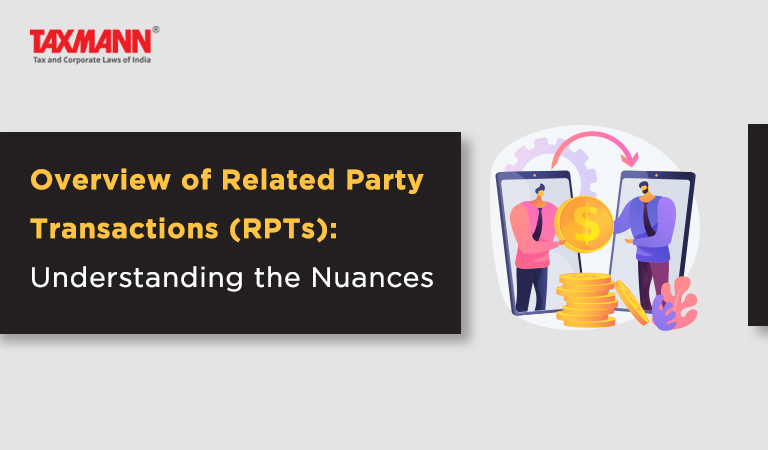Overview of Related Party Transactions (RPTs): Understanding the Nuances
- Blog|News|Company Law|
- 3 Min Read
- By Taxmann
- |
- Last Updated on 7 February, 2023
A Related Party Transaction is a transfer of resources, services or obligations between a company and a Related Party, regardless of whether a price is charged or not. A transaction with a related party shall be construed to include a single transaction or a group of transactions in a contract/arrangement.
Related party relationships are a normal feature of commerce and business. For example, entities frequently carry on parts of their activities through subsidiaries, joint ventures and associates. In those circumstances, the entity has the ability to affect the financial and operating policies of the investee through the presence of control, joint control or significant influence.
A related party relationship could have an effect on the profit or loss and financial position of an entity. Related parties may enter into transactions that unrelated parties would not. For example, an entity that sells goods to its parent at cost might not sell on those terms to another customer. Also, transactions between related parties may not be made at the same amounts as between unrelated parties.
The profit or loss and financial position of an entity may be affected by a related party relationship even if related party transactions do not occur. The mere existence of the relationship may be sufficient to affect the transactions of the entity with other parties. For example, a subsidiary may terminate relations with a trading partner on the acquisition by the parent of a fellow subsidiary engaged in the same activity as the former trading partner. Alternatively, one party may refrain from acting because of the significant influence of another—for example, a subsidiary may be instructed by its parent not to engage in research and development.
For these reasons, knowledge of an entity’s transactions, outstanding balances, including commitments, and relationships with related parties may affect assessments of its operations by users of financial statements, including assessments of the risks and opportunities facing the entity.
Although related-party transactions are themselves legal and also sometimes required for smooth functioning of company’s operations, however they may create conflict of interest or lead to other illegal situations. If left unchecked, the misuse of related-party transactions could result in fraud and financial ruin for all parties involved.
Classification of Related Parties
Following are the broad categories of related parties which fall within the ambit (purview) of related party in regulatory mechanism and transactions with these parties become related party transactions.
(a) Holding, Parent, Associate, Subsidiary Companies.
(b) Subsidiaries of a Common Parent
(c) Trusts and Entities for the benefits of employees
(d) Key Management Personnel including directors
(e) Immediate Family members of point (d) above
(f) Affiliates of points (d) and (e) above.
Classification of Related Party Transactions
(a) purchase or sales of goods (finished or unfinished);
(b) purchase or sales of property and other assets;
(c) rendering or receiving of services;
(d) leases;
(e) transfer of research and development;
(f) transfer under license agreements;
(g) transfer under finance arrangements (including loans and equity contributions in cash or in kind);
(h) provision of guarantees or collateral;
(i) commitment to do something if a particular event occurs or does not occur in the future, including executor contracts (recognized and unrecognized);
(j) settlement of liabilities on behalf of the entity or by the entity on behalf of that related party;
(k) management contracts including for deputation of employees.
Click Here To Read The Full Article
Disclaimer: The content/information published on the website is only for general information of the user and shall not be construed as legal advice. While the Taxmann has exercised reasonable efforts to ensure the veracity of information/content published, Taxmann shall be under no liability in any manner whatsoever for incorrect information, if any.

Taxmann Publications has a dedicated in-house Research & Editorial Team. This team consists of a team of Chartered Accountants, Company Secretaries, and Lawyers. This team works under the guidance and supervision of editor-in-chief Mr Rakesh Bhargava.
The Research and Editorial Team is responsible for developing reliable and accurate content for the readers. The team follows the six-sigma approach to achieve the benchmark of zero error in its publications and research platforms. The team ensures that the following publication guidelines are thoroughly followed while developing the content:
- The statutory material is obtained only from the authorized and reliable sources
- All the latest developments in the judicial and legislative fields are covered
- Prepare the analytical write-ups on current, controversial, and important issues to help the readers to understand the concept and its implications
- Every content published by Taxmann is complete, accurate and lucid
- All evidence-based statements are supported with proper reference to Section, Circular No., Notification No. or citations
- The golden rules of grammar, style and consistency are thoroughly followed
- Font and size that’s easy to read and remain consistent across all imprint and digital publications are applied








 CA | CS | CMA
CA | CS | CMA


